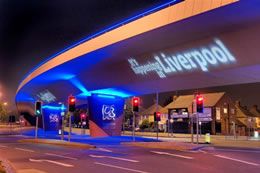Being named European Capital of Culture 2008 was without doubt a proud day for the City of Liverpool. As such the M62 Rocket Junction plays an important part in establishing a first impression for visitors, investors and the travelling public.

FAST FACTS
The development of LEDs has meant that lighting installations can achieve impressive energy saving and impact indirectly on CO2 emissions.
Industry:
City Beautification
Location:
M62 Rocket Junction – City of Liverpool
Lighting products:
- Philips PROflood and MASTERColour 150 W SA lamps
- Blue FlexiLED
Benefits:
• Excellent illumination
• Assurance of instant re-start
• Impressive energy savings per annum
• Longer lifetime – 50,000 hours-
• Reduction of calls outs by service engineers
• Creation of a sense of arrival and excitement for the City of Liverpool
The Challenge:
The vision for this gateway was to provide a lasting experience when entering the city by enhancing the environment and giving particular focus to the dominating Queens Drive Flyover at the end of the M62 motorway.
The Solution:
Fundamental to this was the creation of a night-time ambience, recognising the importance of the evening scene, with the City functioning across 24hrs. This was achieved by uplighting the flyover and creating artistic images to provide a sense of place and identity.
On exiting Queens Drive, road users are now given a warm welcome which underscores the city’s objective that Liverpool is where “it is happening”. The welcome message has been created by projecting lettering on to the underside of the carriageway using Philips PROflood and MASTERColour 150 W SA lamps. Should the greeting need to be changed, for event management purposes, this can be easily done by simply interchanging the existing gobo with new wording or images.
The PROflood (pictured right) light gun incorporates an optical assembly with a gobo holder so that it can project images, patterns and literally “sculpt” light to accurately frame architectural details tailoring the effect exactly as needed. A similar treatment has been given to the vertical planes of the columns supporting the flyover where “08 Liverpool Capital of Culture” is boldly emblazoned on the vertical plane.
In addition the flyover has been defined by blue FlexiLED being positioned along its length, a far cry from the sombre grey brickwork normally associated with highways and urban conurbations.
The Benefits:
As Chris Founds, project manager for 2020 Liverpool explains, “What we wanted to achieve was to create a sense of arrival and excitement instilling civic pride in all those living, working and visiting the area. It was also important that we sought out the opinions of the local community in order to make the project a success. We succeeded in doing this and are delighted that both residents and businesses are happy as they feel their area has been improved. The project has refreshed and reinvigorated a tired and neglected structure and is now something that we can all be proud of and will have a lasting legacy.”
Whilst it was important to create visual impact it was vital to do so in a way which did not produce glare and impair the safety of those travelling through the junction. Adopting LED solutions overcame this potential hazard since drivers are not affected by any direct line of the light sources used.
The upper columns of the structure have been colour washed in blue using LEDline modules giving a floating effect to the flyover itself. Indeed the system is very versatile and offers the opportunity to create any colour giving scope to realise new possibilities not achievable with other technologies.
Moreover, the development of LEDs has meant that lighting installations can achieve impressive energy savings per annum, and impact indirectly on CO2 emissions, when compared with conventional solutions available a decade ago. In a typical installation such as this, for example, traditional floodlighting methods would easily use at least 30% more energy than the new LED systems.
Not only that, but this energy efficient, compact new light has a lifetime of 50,000 hours, which is approximately 25 years making it a truly “fit and forget” installation! This reduces the need for frequent call outs by service engineers since the system is virtually maintenance-free whereas traditional lighting technologies would have to be replaced approximately every 4-5 years. What better example of how lighting can be visually stunning, practical and environmentally friendly as well?





 CN
TW
EN
CN
TW
EN






